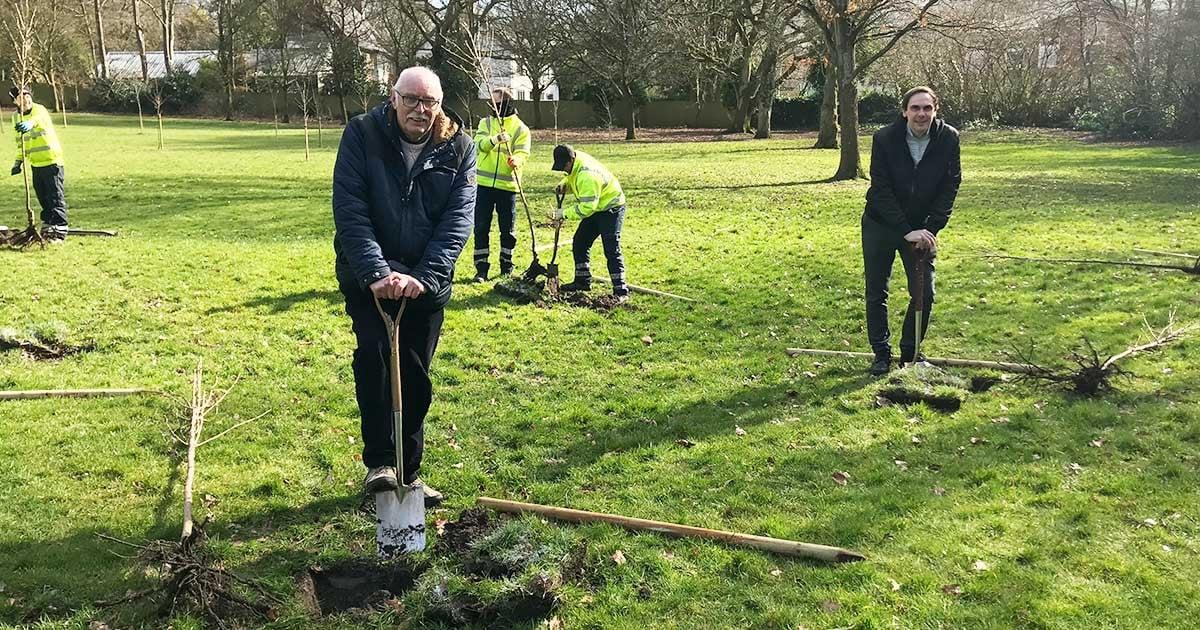Green spaces to become Urban Carbon Capture Areas as tree-planting scheme takes root

Cabinet designates the first Urban Carbon Capture Areas in the borough
Newcastle’s Cabinet today designated large areas of Council-owned green space in some urban areas of the borough as Urban Carbon Capture Areas (UCCAs).
The areas will be protected in the Open Spaces and Green Infrastructure Strategy and will be put forward for designation in the developing Local Plan.
The Leader of the Council, Simon Tagg, said: “In developing these UCCAs we are responding to our resident’s concerns and protecting urban green spaces across the borough. The green spaces will contribute to the Council’s carbon reduction goals for generations to come as part of the Sustainable Environment Strategy, adopted by this administration last year to prioritise a sustainable future for the borough.”
“The programme of tree planting on green spaces taking place over the next year, when taken as a whole, equates in size to the area of ten football pitches. The UCCAs will be protected by specific conditions that will prevent them being sold off for development in future.”
Green spaces in Clayton, May Bank, Chesterton, Bradwell, Kidsgrove and the Westlands have been included as UCCAs, some of which have been under threat of development or house building in the past.
Cllr. Tagg added: “Greens spaces such as Clayton Field, The Grumbles in Chesterton and the green by Arnold Grove in Bradwell will now be protected in Council policy and will provide the important urban ‘green lung’ for local people as well as contributing to the borough’s carbon offset target for years to come.”
To kick-start the Council’s commitment to UCCAs residents in some of the most urban areas will be asked to take part in the rolling-out of the new and ambitious Urban Tree Planting Strategy. Phase One took place in December last year to mark National Tree Week with 30 trees planted at Sandy Lane, in Newcastle, and 30 at Newchapel Recreation Ground.
Phase Two will see tree planting proposals for Westbury Road in Clayton, Hanbridge Avenue in Bradwell, Repton Drive and Winchester Drive in the Westlands and Wilson Street in Newcastle’s town centre ward. Residents will be able to select trees from a range of native broadleaf trees and fruit trees - whichever species are considered most suitable to each site. These will include Field Maple, Acers, Silver Birch, Hornbeam, Lime and Beech with Apple, Pear, Plum and Cherry trees.
Cabinet member for Sustainable Environment, Energy Efficiency and Climate Change, Trevor Johnson said: “Planting these sites with specially selected native trees and designating them as urban carbon capture areas marks the start of the Council delivering on its commitment to protecting the local environment for generations to come.
“From small acorns, mighty oaks grow and over the coming years more and more areas of urban open space will also be planted with trees. My hope is that residents will embrace what we’re trying to do, for now and for the future, and will join us by getting involved – maybe even plant a tree or two themselves.”
Phase Three of the strategy will take place in the autumn and will consider proposals for planting in other areas and wards in the borough.
By 2023, the Council aims to have planted at least 850 trees throughout the borough to link with the 850th anniversary of the Newcastle Charter. There is a ‘tree-totalizer’ on the Council’s website where the number of trees planted as part of the Urban Tree Planting Scheme is being recorded, along with their location, as the campaign evolves.
In November 2021 the Council was the first in Staffordshire to adopt a Nature Recovery motion in recognition that nature is in long-term decline and action is needed to halt and reverse this urgently. The Council acknowledged that more space should be given to wildlife, existing wildlife spaces should be expanded and the connectivity between wildlife spaces should be improved.
More information on the tree-planting strategy can be found here: https://www.newcastle-staffs.gov.uk/environment/urban-tree-planting-proposals
Details about consultation with residents in the proposed planting areas can be found here: https://www.newcastle-staffs.gov.uk/public-consultations
Today’s Cabinet agenda can be seen in full on the Council’s website and a recording of the meeting can be found using this link: https://tinyurl.com/bdmevsrx

